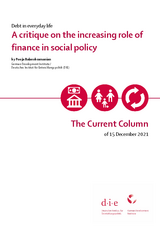Debt in everyday life
A critique on the increasing role of finance in social policy
Balasubramanian, PoojaThe Current Column (2021)
Bonn: German Development Institute / Deutsches Institut für Entwicklungspolitik (DIE), The Current Column of 15 December 2021
In the book ‘Debt: The first 5000 years’, David Graeber reminded us that debt always had an important place in the history of humanity and class struggles. However, it is only after the 2008 Global Financial Crisis, which exacerbated household debts, that the critical role of finance and debt in everyday life became more prominent. Today we experience a ‘crisis of care’ which is demanding higher working hours, offers reduced or privatised social welfare, and forces people to borrow for social reproduction such as consumption, healthcare, education and housing. Throughout the pandemic, social movements across many developing countries have emerged, demanding the immediate cancellation of unfair debt. Alongside these movements, a report was published by the UNHCR in 2020 highlighting the human rights violations in the context of private debt – especially individual and household debt.
In a standard economic textbook, debt (credit) is considered a tool for ‘greasing the wheels’ of a household (economy). There is an expectation within development cooperation that access to loans for the poor will bootstrap them out of poverty, and the untapped financially excluded groups can become allies in enabling economic growth. While access to credit per say is not the problem, it is over-indebtedness, the abusive contractual terms and collection practices that can quickly turn an empowering tool into a debt trap. Furthermore, conditions such as stagnant wage growth, accompanied by precarious jobs and the slow demolition of the welfare state push households to borrow for consumption, thereby creating an unending cycle of indebtedness amongst poor.
One gap that is rarely discussed in research is the increasing penetration of finance within social policy that is further pushing individuals and households into a debt-poverty trap. What does this entail? What are the potential alternatives to achieve a sustainable model for development with regard to finance and debt?
Financialisation of social policies
The term financialisation addresses an increasing role of financial markets, actors and institutions, and the fact that profits occur through financial channels. Financialisation in the realm of social policy can be observed through an increased push towards financial inclusion and emphasis on providing microfinance, and the use of income transfers. The primary objective was to boost consumption and increase market nexus by integrating the poorest population groups within the system. By making social policy primarily dependent on facilitating credit access, financial inclusion is bearing the onus for poverty alleviation. And cash transfers that form a bulk of the social schemes are eroding the notions of universality and de-commodification, pillars of an ideal social protection framework advocated by the International Labor Organization. Individuals are now required to ‘purchase’ public goods that are supposed to be provided by the state.
Another aspect of financialisation is the introduction of various forms of payment and financial technologies whereby repayment instalments are deducted automatically from paychecks. Such a form of credit tied to the income is known as consigned credit, predominantly used by civil servants or formal salaried employers. Nowadays, we see such a type of lending where the income becomes a collateral, applied to social transfers received by the beneficiaries. Examples of this are the “Bolsa Familia” in Brazil or the South African cash transfer programme. Governments, International Financial Institutions and financial companies are increasingly joining the financial inclusion bandwagon, and why not? There are close to two billion adults without a bank account, all of them are potential customers, and the cash transfer becomes the tool of a risk-free profit for the institutions offering the loan. As Susanne Soederberg writes, there are ‘No more welfare states but debtfare states’.
Movements against the ‘collateralisation’ of social policy
There has been increasing public mobilisation across the world, with some of the prominent movements being the Strike Debt, Debt Collective and Occupy Wall Street and organisations such as Jubilee South and the Committee for Abolition of Illegitimate Debt (CADTM) at the forefront. Some of the alternatives they propose to achieve a fair and just model of development include complete moratorium of public debt repayment and cancelation of unjust personal debt (student debt, abusive mortgage loans, microcredit loans), regulation of banks and financial corporations (NBFCs), imposition of taxation on assets and wealth and radical increase in public expenditure (focusing on universal healthcare and education). Currently across different developing countries, the Committee for the Abolition of Illegitimate Debt (CADTM) is coordinating workshops to train citizens to undertake Debt Audits to identify such unfair debts. Although it is currently difficult to predict the outcomes of the various ongoing social movements, studies by organizations such as UNCTAD and UNHCR that have directly addressed the link between illegitimate, unfair household indebtedness and human development are a silver lining.

